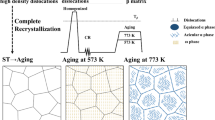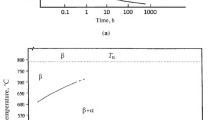We use three commercial economically alloyed metastable titanium β-alloys (TIMETAL-LCB (wt.%): Ti–1.5Al–4.5Fe–6.8Mo, Ti–4.3Fe–7.1Cr–3Al, and Ti–1Fe–13Cr–3Al) to perform the comparative analysis of the influence of individual alloying elements on the kinetics of decomposition of the metastable β-phase quenched from the temperatures of the monophase β-region in aging. The roles played by alloying elements, such as molybdenum, iron, and chromium, are clarified. The experimental results are compared with the results of parallel computations by using the DICTRA software. We propose a new composition of economically alloyed titanium β-alloy in which Ti–1.5Al–4.5Fe–6.8Mo alloy is taken as the base and molybdenum is replaced with the equivalent amount of manganese (4%). It is shown that this alloy is promising for practical applications.







Similar content being viewed by others
References
P. J. Bania, “Beta titanium alloys and their role in the titanium industry,” in: Beta-Titanium Alloys in the 90’s, TMS Publications, Warrendale (1993), pp. 3–14.
D. Eylon, “Beta-titanium alloys—an overview,” in: Proc. of the 3rd Japan Internat. SAMPE Symp, SAMPE, Tokyo (1993), pp. 1588–1595.
O. M. Ivasishin, P. E. Markovsky, Yu. V. Matviychuk, et al., “Comparative study of the mechanical properties of high-strength beta-titanium alloys,” J. Alloys Comp., 457, 296–309 (2008).
P. E. Markovsky and M. Ikeda, “Balancing of mechanical properties of Ti–4.3Fe–7.1Cr–3.0Al using thermomechanical processing and rapid heat treatment,” Mater. Trans. JIM, No. 7, 1515–1524 (2005).
M. Ikeda, S. Komatsu, K. Inoue, et al., “Microstructure and tensile properties of Ti–Fe–Cr alloys,” Mater. Sci. Technol., 16, 605–608 (2000).
M. Ikeda, S. Komatsu, M. Ueda, et al., “Influence of aluminum addition on tensile properties and aging behavior of Ti–Fe–Cr–Al alloys,” in: S. Hanada, Z. Zhong, S. W. Nam, and R. N. Wright (editors), Proc. of the 4th Pacific Rim Internat. Conf. on Advanced Materials and Processing (PRICM4), Japan Institute of Metals. Sendai (2001), pp. 213–216.
P. E. Markovsky, M. Ikeda, and M. М. Ogawa, “Comparative study of different low-cost beta titanium alloys highly strengthened using cold deformation and rapid recrystallization approach,” in: M. Niinomi, S. Akiyama, M. Hagiwara, et al. (editors), Proc. of 11th World Conf. on Titanium, Japan Institute of Metals, Sendai (2007), pp. 933–936.
V. N. Gridnev, О. M. Ivasishin, and P. E. Markovskii, “Influence of the heating rate on the temperature of polymorphic transformations of titanium alloys with different degrees of alloying,” Metalloved, Term. Obrab. Met., No. 1, 31–35 (1985).
A. Engstroem, L. Hoeglund, and J. Agren, “Computer simulation of diffusion in multiphase systems,” Metal. Mat. Trans. A, 25a, 1127–1134 (1994).
O. M. Ivasishin and D. G. Savvakin, “The impact of diffusion on synthesis of high-strength titanium alloys from elemental powder blends,” Key Eng. Mater., 436, 113–121 (2010).
U. Zwicker, Titan und Titanlegierungen, Springer, Berlin (1974).
M. A. Krivoglaz, “Short-order structures in metal alloys,” Metallofizika, No. 1, 3–36 (1984).
S. G. Fedotov, “Metastable phases in titanium alloys; mechanism and kinetics of their formation,” in: Investigation of Metals in Liquid and Solid States [in Russian], Nauka, Moscow (1964), pp. 207–238.
O. M. Ivasishin, P. E. Markovsky, S. L. Semiatin, and C. H. Ward “Aging response of coarse- and fine-grained beta-titanium alloys,” Mater. Sci. Eng. A, 405, 296–305 (2005).
Y. C. Huang, S. Suzuki, H. Kaneko, and T. Sato, “Continuous cooling transformation of beta-phase in binary titanium alloys,” in: R. I. Jaffee and N. E. Promisel (editors), The Science, Technology and Application of Titanium, Pergamon Press, Oxford (1966), pp. 695–698.
Author information
Authors and Affiliations
Corresponding author
Additional information
Translated from Fizyko-Khimichna Mekhanika Materialiv, Vol. 49, No. 1, pp. 78–84, January–February, 2013.
Rights and permissions
About this article
Cite this article
Markovs’kyi, P.E., Ikeda, M. Influence of alloying elements on the aging of economically alloyed metastable titanium beta-alloys. Mater Sci 49, 85–92 (2013). https://doi.org/10.1007/s11003-013-9586-2
Received:
Published:
Issue Date:
DOI: https://doi.org/10.1007/s11003-013-9586-2




